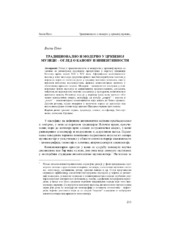Prikaz osnovnih podataka o dokumentu
The traditional and modern in church music: A study in canon and creativity
Tradicionalno i moderno u crkvenoj muzici - ogled o kanonu i inventivnosti
| dc.creator | Peno, Vesna | |
| dc.date.accessioned | 2018-05-07T11:23:33Z | |
| dc.date.available | 2018-05-07T11:23:33Z | |
| dc.date.issued | 2006 | |
| dc.identifier.issn | 1450-9814 (print) | |
| dc.identifier.uri | https://dais.sanu.ac.rs/123456789/2593 | |
| dc.description.abstract | Definitions of the terms "traditional" and "modern", relating to the chanting tradition of the Eastern Church, sprang from research into so-called kalophony - a specific compositional method that established melismatic melody. Despite differing academic opinions about the origins of this melody in the liturgical practice of the Eastern Church, it is evident that very embellished and elaborate kalophonic melodies appeared frequently from the mid-13th century onwards. The compositional treatment of various genres of these melodies began historically with partial respect for the established hymnographic text. This was followed by a more liberal arrangement, ending in a total departure from any textual base (kratema). The fact that the melody in melismatic mode superseded the text suggests that kalophony represented a certain kind of modernity. Even though musical manuscripts in neumatic notation had no written rules about methods of composition or how to balance tones and words, in the tradition of the Easternchanting practice, melody was always recognized as a helpful addition, an exegesis of the textus receptus. In order to fully comprehend the introduction of this "new sound" and "new style", this study focuses on the work of a major protagonist of them, a monk from the Great Lavra, blessed John Koukouzeles. I consider the following questions: 1) The purpose and function of chant in the art of Byzantium in general 2) The role of the composer/ artist and his creative freedom 3) Evaluating criteria for church-related arts/composition 4) Criteria which immortalized or buried artwork/composition of the time Allowing for what possibly motivated John Koukouzeles and his contemporaries to compose kalophonic melodies or to kalophonically modify old, traditional melodies this study focuses on the effects that hesychasm had on the chanting practice of the time. Considering the theological validation of kalophonic modifications of some liturgical hymns, an attempt was made to interpret the introduction of kalophony as a reflection of prevailing tendencies in Byzantium church life at the dawn of its demise, which affected all areas of artistic production. One of the leading hesychast theologians of the time St. Gregory of Palama (who shared at one point monastic community with St. John Koukouzeles in the Great Lavra) questioned whether continuous prayer simultaneous to breathing, a practice taught by hecychasts, could influence composers in their chanted prayer. Did they too want to prove that chanting which acts (in time), as continual prayer, leads to unity with God? Did the composers seek melodies that would express the apophatic, melodies that no longer needed words? Could it be that the result of their creativity (kalophony) replaced the old poetics of the chanting art with the newly discovered beauty of their sound? In this study, the questions of whether the 14th century found its Ars Nova in Byzantine named manuscripts and whether these new compositional principles preceded modernism, or were, as implied by the aforementioned questions, a reinforcement of the tradition with a new means of expression, is answered by the fact that the Eastern Church included John Koukouzeles in the assembly of the saints. Thus, his opus, albeit new was recognized in the foundational spirit, and as such, endures through the history on its way to Eshaton. | en |
| dc.description.abstract | Ogled o tradicionalnom i modernom u crkvenoj muzici se zasniva na razmatranju svojevrsne prekretnice u pojačkoj tradiciji Istočne crkve tokom XIII i XIV veka. Afirmisanje melizmatičnog napeva u kome melodija preuzima primat nad bogoslužbenim tekstom je pojava sa kojom se naizgled ruše u predanju vekovima ustaljena, iako u pisanim izvorima neposvedočena, pravila kompozitorske veštine u obličavanju crkvenog melosa. Moderni - kalofonični postupci u komponovanju novih melodija i aranžmanima tradicionalnih, sagledani, međutim iz perspektive opštih tendencija u kulturnom, političkom i crkvenom životu Vizantije koje je u periodu pred njenu propast obeležio isihastički pokret potvrđuju da između "starog" - kanona i "novog" - kompozitorske inventivnosti nije došlo do bitne promene. Drugim rečima, pojave modernog u muzičkom izrazu su drugačiji vid ispoljavanja jedne istine koju crkveno Predanje očuvava kroz vekove. | sr |
| dc.rights | openAccess | |
| dc.rights.uri | https://creativecommons.org/licenses/by-nc-nd/4.0/ | |
| dc.source | Музикологија / Musicology | |
| dc.subject | crkveno pojanje | sr |
| dc.subject | tradicija | sr |
| dc.subject | simvol | sr |
| dc.subject | kalofonija | sr |
| dc.subject | bogosluženje | sr |
| dc.subject | isihazam | sr |
| dc.subject | Predanje | sr |
| dc.title | The traditional and modern in church music: A study in canon and creativity | en |
| dc.title | Tradicionalno i moderno u crkvenoj muzici - ogled o kanonu i inventivnosti | sr |
| dc.type | article | |
| dc.rights.license | BY-NC-ND | |
| dcterms.abstract | Пено Весна; Традиционално и модерно у црквеној музици - оглед о канону и инвентивности; Традиционално и модерно у црквеној музици - оглед о канону и инвентивности; | |
| dc.citation.spage | 233 | |
| dc.citation.epage | 250 | |
| dc.citation.issue | 6 | |
| dc.identifier.doi | 10.2298/MUZ0606233P | |
| dc.type.version | publishedVersion | |
| dc.identifier.fulltext | https://dais.sanu.ac.rs/bitstream/id/20330/2671.pdf | |
| dc.citation.other | (6): 233-250 | |
| dc.identifier.rcub | https://hdl.handle.net/21.15107/rcub_dais_2593 |

